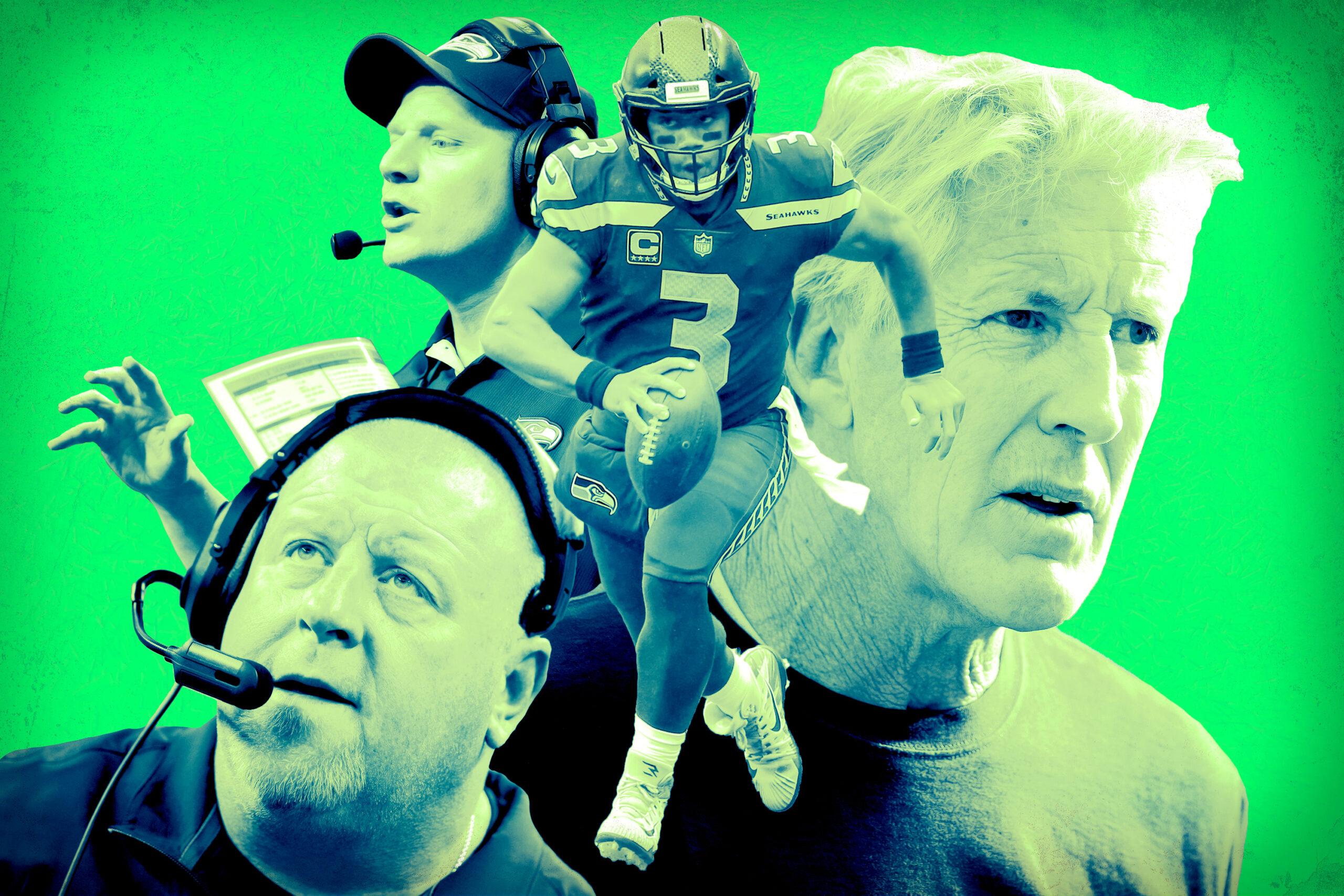
The Seahawks came into the season looking like one of the favorites in the NFC, especially after trading with the Jets for defensive tackle Sheldon Richardson, who appeared to be the capstone piece for an already elite defense, just a week before the season. But after two weeks and a 1-1 start, a lot of Seattle’s Super Bowl–contender shine has come off. The defense remains predictably stout, sure, but the Seahawks offense has been a complete disaster. Like, wreck-the-season-level bad.
For the first seven and a half quarters of play, the offense didn’t have any semblance of a run game, and it didn’t score its first touchdown of the year until the 7:06 mark of the fourth quarter in Seattle’s sure-didn’t-feel-like-a-win win over the 49ers on Sunday. The offensive line has been terrible, and Russell Wilson’s off to his slowest start as a pro, with career-worst numbers through two games of a season in yards per attempt (5.4), passer rating (76.3), and completion percentage (56.1). Doug Baldwin has just 10 catches for 107 yards and no scores, and Jimmy Graham’s gained just 9 yards on 10 targets. Only the Colts and Texans, both of whom have already benched their season-opening quarterbacks, have averaged fewer than Seattle’s 4.2 yards per play.
The only thing that’s keeping Seahawks fans from going into full-on panic mode (not that some haven’t already) is that Pete Carroll’s team has an annoyingly consistent history of turning ugly, slow starts into respectable playoff runs. Take last season, for instance, when Seattle scored 15 points (and just one touchdown) in its first two games as it started 1-1. Or maybe 2015, when the team opened the year 0-2, losing to the Rams and Packers. But while there’s a feeling of familiarity to Seattle’s sluggish start, things have never felt quite so grim on the offensive side of the ball. The question has to be asked: Is this just another stumble out of the gates for Seattle, or are the Seahawks in real trouble?
Going back to his days at USC, Carroll has tried to master the art of peaking at the right time. Winning early is never bad, obviously, but his goal is to build up to the highest level of performance, so that his team is firing on all cylinders late in the season when the games matter most. Carroll cultivated a “No-Lose November” motto and a cumulative 25-1 record in that month over his nine years in Southern California. In Seattle, he’s tried to keep that tradition alive. The numbers bear that out.
During the Wilson era (from 2012 through 2016), Seattle’s gone 11-6 (.647) in the month of September (17 games), averaging 22.8 points per game for an overall point differential of plus-119. Compare that with the team’s average numbers from the final five games of each season in that same time period (25 games), when Seattle’s gone 20-5 (.800) and averaged 28.2 points per game with a whopping plus-397 point differential. In fact, if you widen the scope to the first and second halves of the season over the last five years, the Seahawks’ splits look like this:
First eight games: 25-14-1 (.638), 21.9 points per game, plus-169 point differential
Final eight games: 31-9 (.775) 28.1 points per game, plus-532 point differential
Wilson’s passing numbers have followed a similar track, and he gets sharper as the year goes on. Over his first five seasons in the league, his monthly passing splits look like this:
September: 3,479 yards at 7.17 YPA with 22 touchdowns to 11 picks and a 91.6 rating
October: 4,585 yards at 7.88 YPA, 25 touchdowns to 11 picks, and a 95.0 passer rating
November: 4,403 yards at 8.53 YPA, 33 touchdowns to 8 picks and a 106.9 passer rating.
December: 5,271 yards at 8.26 YPA, 43 touchdowns to 15 picks, and a 103.0 passer rating.
As for Wilson’s career first-half to second-half season splits, here you go (2012 to 2016):
First eight games: 8,735 yards at 7.54 YPA, 50 touchdowns to 23 interceptions, 93.2 rating
Final eight games: 9,458 yards at 8.42 YPA, 77 touchdowns to 22 interceptions, 106.1 rating
Seattle is a second-half team, and Wilson is a second-half passer. But past performance doesn’t always predict the future, and Wilson has never played quite this poorly behind an offensive line that’s this bad.
The combination of, from left to right, Rees Odhiambo, Luke Joeckel, Justin Britt, Mark Glowinski, and Germain Ifedi has not worked. The 49ers got pressure on Wilson 21 times last Sunday, and somehow, Seattle’s offensive line was even worse in the run game—at least until the final quarter, when running back Chris Carson racked up 58 of his 93 total yards to help the Seahawks retake the lead and put away the game. But it was Seattle’s defense that saved the day, as the only reason the Seahawks were in the position to salt the game away at the end was that they’d held 49ers quarterback Brian Hoyer to 99 yards passing on 27 attempts, or 3.67 yards per attempt.
Assuming its stars (especially Earl Thomas) can stay healthy, the Seahawks defense is going to continue to give the team a chance to compete in just about every game. But without an extraordinary, transcendent performance from that side of the ball this year, Seattle’s got no hope for another Super Bowl run with the offense looking this rudderless. In the past, those annual second-half surges from Wilson and Co. have helped turn the Seahawks into one of the most balanced teams in the league—the reason they’re always so dangerous come playoff time. But the offensive line has played at such a poor level out of the gates, that without a big jump in performance up front—or a wholesale change of strategy scheme-wise—the offense may not be able to put the pieces together this time.
But there’s still plenty of time for that group—or some other line combination, which Carroll implied we may see this week—to improve, at least marginally. Seattle’s zone-blocking linemen have always tended to hit their stride later in the season as the players begin to jell. Like every other team in the league, a lack of full-pads practices during the preseason means that offensive linemen come into the year with a shortage of live reps. But Seattle has put itself at a bigger disadvantage than most this year because of a lack commitment to continuity at the position. Britt (at center) is the team’s only starter to return at the same position he played last season. Odhiambo made his first career start at left tackle in Week 1; Joeckel, who was signed in free agency in the offseason, made his first start for the team at left guard (and just his fifth at that spot in his career); Glowinski had just one start at right guard prior to this year; and Ifedi, zero starts at right tackle.
The Seahawks giving their linemen a steep learning curve has become a yearly tradition, and while the team isn’t trying to flip another college defensive lineman to the other side of the trenches, this group still does need time to learn to work together as a unit. That means that if Seattle has designs for a shake-up on the line—maybe benching Glowinski for veteran guard Oday Aboushi or giving rookie lineman Ethan Pocic a chance to win a spot—it makes sense to pull the trigger on a move sooner rather than later so they can jell before it’s too late.
Until the line does come together and improve—or, especially if it never does—Seattle may need to drastically change its style on offense. That means that instead of the slow, smashmouth-run-based ball-control system that Carroll’s teams typically employ, the Seahawks may need to lean more heavily upon an up-tempo, no-huddle, and spread-out look that they run more frequently in two-minute and late-game situations. Wilson appears to be most comfortable as the point guard of the offense in that role, where he can spread his offensive weapons out, get the ball out of his hands quickly, and take off and run more easily. This isn’t a foreign concept to Carroll—the team went to this type of strategy back in 2011 with Tarvaris Jackson at quarterback in order to jump-start a stalled offense and help mitigate some issues with protection, and they’ve done it in short bursts over the past few years as a changeup—so it’s still something that the Seahawks have up their sleeve.
Per the Tacoma News Tribune’s Gregg Bell, Seattle has scored nine points and averaged 3.1 yards per play running its typical slow-paced, huddle-based offense so far this season. On drives where the Seahawks have sped the tempo up or gone with a no-huddle approach, they’ve averaged 14.2 yards per play and scored 12 points (including their only touchdown, a throw by Wilson to Paul Richardson last week, the eventual game-winning play). Seattle’s offense had the same type of success in the up-tempo style last year, too. And while using those numbers as a one-to-one comparison can be misleading—in some cases, teams back off into prevent mode in two-minute drills, which can help boost passing numbers—the no-huddle/up-tempo strategy is still a card the Seahawks can play if these offensive issues persist.
It’s much too early to determine whether the Seahawks’ slow start on offense is a glimpse at a season-long trend or just another data point on the team’s typical season arc. We’re still relying on too small of a sample size—after all, we might be having a different conversation about the Seahawks offense all together if not for a pair of big drops by receiver Tanner McEvoy (the first should’ve been a touchdown and the second was a drive-killing drop on third down) and another by running back C.J. Prosise last week. If either of those players had made those plays—none of which had an especially high degree of difficulty—Seattle might’ve won comfortably instead of squeaking out an ugly win against a bad team at home.
Going forward, Seattle still has plenty of ways to take a defibrillator to a flatlining offense. Whether it’s the marginal improvement of a bad offensive line that helps spring running back Chris Carson a few more times a game and gives Wilson an additional half-beat to throw on a handful of more dropbacks, or a bolder strategy to move to a no-huddle hurry-up offense, the Seahawks haven’t exhausted all of their avenues for improvement. Of course, with the slow-playing, peak-at-the-right-time Carroll running the show, we may not see much change over the next few weeks. And who is to say that sticking with that plan is the wrong move? It’s worked for Carroll and Wilson before.

